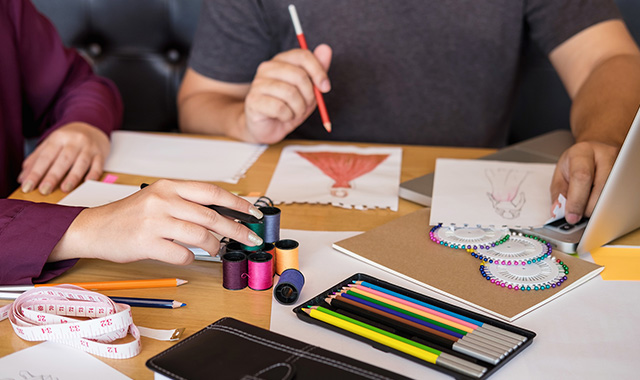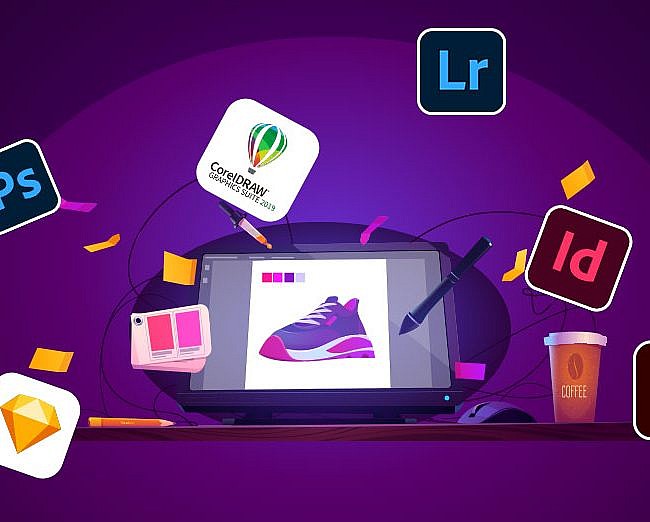Some designs are immediately known at a glance: the Mercedes brand symbol, the New York Yankees overlapping NY, the Nike Swoosh, the Louis Vuitton checkerboard.
The design is being leveraged in every industry to help companies stand out amongst the competition, develop a strong identity through visual association, promote quality, luxury, or status, and elevate utility and function. The textile, furniture, and interior design industries are utilizing fabric texture design to better showcase their products and carve out a corner of a highly competitive market for themselves.
Elements of Design Texture Utilized by Leading Designers
Coveted high fashion designers like Ralph Lauren, Fendi, Louis Vuitton, and Kate Spade are just a few of the major designers that have extended their fashion brand designs into textiles, furniture, fabrics, barware, and another home decor. They reside amongst the many industry brands who are turning fabric texture design into a revenue grossing, a trendsetting, consumer-driven, and technology-enhanced business that straddles the worlds of fashion, art, design, and service.
Fabric texture design has become associated with quality, innovation, and position. Chanel has taken quilted texture design and turned it into a symbol of high fashion, good taste, and classic design, beloved the world over by tastemakers, celebrities, and the masses. Louis Vuitton has turned their intertwined LV trademark into a famous design across luggage, purses, shoes, clothing, and accessories that have even been referenced in music, literature, and entertainment. Burberry has transformed tartan plaid into a symbol of elegance across men and women’s clothing and accessories, jewelry, beauty products, and homeware.
Understanding the ins and outs of the industry, and how to create, produce, and generate your designs effectively will help designers sell their products and differentiate themselves from competitors.
What’s Selling Now
Trends in Clothing
Current trends in clothing, interior, and furniture are setting industry standards for popular design elements and design representation. These achievements are recognized by global industry awards and witness in the shifting consumer focus towards design elements that add personality, originality, and artistry to decor, clothing, and furniture.
-
 Color
ColorImportant design concepts are centered around features like color, texture, and shape. The color palettes that designers feature in their wares have a trickle-down effect on the entire fashion industry from the New York, and Paris runway shows down to mainstream department fashion. Designers use color to create a rich range of effects from contrast and emotional, manipulation, to Trompe de L’oeil effects that truly trick the eye and delight viewers.
-
 Texture
TextureMonochromatic patterns combined with different textures add dimension and contrast to spaces. Some popular texture trends for both commercial and residential spaces include dark woods, metallic details and finishes, and clever applications of color and texture balanced with visual appeal and durability. Other popular materials and textures right now are felt, silk, leather, cork, and stone, and a focus on natural and organic elements and organic for both internal and external in design spaces.
Awards and Recognition in This Market: The clothing design industry features some coveted awards and global recognition that spurns competition:
-
01Good FashionDesign Award
Designers who push the envelope of innovation and originality, mixing ergonomic design and functionality are awarded this coveted title. Products must feature an in-depth presentation that differentiates the design from other products and demonstrate eases of use, maintenance, transformation, and sustainability.
-
02Textile, Fabric, Textures, Patterns and ClothDesign Award
This design competition is open to all participants and is a great competition for young designers and new professionals in the industry. It features design concepts, prototypes or finished textiles.
-
03The A’ Design Award for Textile, Fabric, Textures, Patterns and Cloth DesignsDesign Award
Is globally recognized as a mark of design excellence and can be a career booster for design studios and professionals. It’s an award for quality and design perfection.
-
 Graphic Design
Graphic DesignGraphic design is a major component in fashion and clothing design, concept lookbooks, swing tags, invitation packaging, are all representations of a designer’s narrative. Graphic design adds brand identity and detail that entices consumers and can create an iconic effect. Consider Chanel, who presents their iconic intertwined double CC graphic design logo across all of their packagings, from tags, boxes, to bags.
Trends in Interior Design

-
 Color
ColorTypically, the focus in interior design skews towards lighting and furniture, but fabric adds color and atmosphere and can change the entire feeling of space. For example, the home design usually features bright and warm colors, while offices tend to utilize dark, muted, and subtle palettes that add professionalism. Functionality also plays a role in the fabric as washable, reusable, and sturdy fabrics are suited for hospitals, restaurants, or hotels, while more delicate fabrics, like silk, are better for less high-traffic areas or pieces.
-
 Texture
TextureThe Fabric Zoom Printer allows print on textured fabric, but very few designers can take advantage of this service. Fabrics with rich textures, stitch patterns, and thick or stretchy fabrics, can also be printed on and it’s a great way to add a personal touch to texture.
-
 Art
ArtInterior designers stress the importance of art in the home and professional spaces, and it’s recognized as the main component of modern homes and commercial areas. A lot of interior brands collaborate with artists and galleries to produce branded artwork and meet growing consumer demand for unique art pieces in the home.
-
 Design to Increase Home Value
Design to Increase Home ValueInterior designers stress the importance of art in the home and professional spaces, and it’s recognized as the main component of modern homes and commercial areas. A lot of interior brands collaborate with artists and galleries to produce branded artwork and meet growing consumer demand for unique art pieces in the home.
-
 Online Startups
Online StartupsOnline designers might be a good option to consider because of the overall lower costs and discounts in their catalog and consolidated purchasing and shipping. Online startups add a level of accessibility and affordability that enables the luxury design to be available to a more widespread audience.
Awards and Recognition in This Market
-
01IDADesign Award
Awards designers and teams of designers for pushing industry standards and boundaries and transforming work and living spaces.
-
02The 2018 NYCxDESIGNDesign Award
International design competition for achievements in major design areas. Winners are published in Interior Design Magazine and promoted on Interior Designs channels.
Trends in Furniture
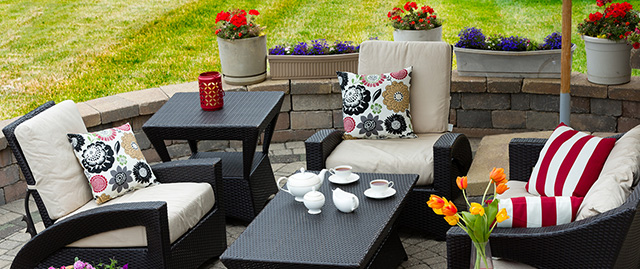
-
 Color
Color2018 is shaping up to be a throwback of the 70’s in furniture design. Lot’s of curves and color with softer shapes and bright saturated pigments. Colors like green, burnt rose, and ochre are very popular, and experts recommend thinking about the shape of the furniture when choosing a fabric and color. For example, larger pieces like a couch should have a solid or classic color that withstands the test of time.
-
 Texture
TextureCushions, throw pillows, and blankets add softness to furnishings and bring texture to spaces. Fabrics like silk, velvet, sheepskin, wool, and cotton add variety and a subdued palette, and both light and dark tones can add color and versatility. Seasonal considerations, inspired by nature, can also bring a beautiful visual appeal. For example, dusky pinks and deep forest greens, are beautiful for winter and warm colors, turquoise, and yellow are attractive for warmer seasons.
-
 E-commerceFurniture is increasingly pervasive on online sights, and new technologies are a part of the buying process. When considering e-commerce for furniture, some factors to focus on include:
E-commerceFurniture is increasingly pervasive on online sights, and new technologies are a part of the buying process. When considering e-commerce for furniture, some factors to focus on include:-
01Customer Personalization
-
02Augmented Reality
-
03Virtual Reality
-
04Apps
-
05Virtual Reality
-
06Apps
-
-
 TechnologyNew technologies are allowing furniture designers to have access to innovative materials and processes. Computer programs allow direct representation of forms that were previously impossible to draw, but can now be translated directly into manufacturing processes. This is allowing for new, exciting forms of expression and structure. Technological shifts are allowing for speedy advances in design fields, and helping designers create new solutions and imaginative forms.
TechnologyNew technologies are allowing furniture designers to have access to innovative materials and processes. Computer programs allow direct representation of forms that were previously impossible to draw, but can now be translated directly into manufacturing processes. This is allowing for new, exciting forms of expression and structure. Technological shifts are allowing for speedy advances in design fields, and helping designers create new solutions and imaginative forms. -
 QualityThe US furniture industry is worth 100 billion dollars, and there are so many brands fighting for consumer recognition and business. Furniture is sold at quality tiers and prices, and it’s important to focus on quality brands that suit your budget and will last.
QualityThe US furniture industry is worth 100 billion dollars, and there are so many brands fighting for consumer recognition and business. Furniture is sold at quality tiers and prices, and it’s important to focus on quality brands that suit your budget and will last.
Awards and Recognition in This Market
-
01International FurnitureDesign Award IFDAThis award helps furniture, interior, and architecture designers showcase emotional and forward-thinking designs for prestige, fame, and publicity.
Industry Breakdown for Fabric Texture Design

- The US apparel market is the largest in the world.
- Clothing store retail sales exceed 15 billion monthly.
- 1.8 million people are employed in the fashion industry.
- 232,000 of these professionals are in textile manufacturing for fashion.
- The graphs below show revenues of graphic design and interior design services in the US, respectively.
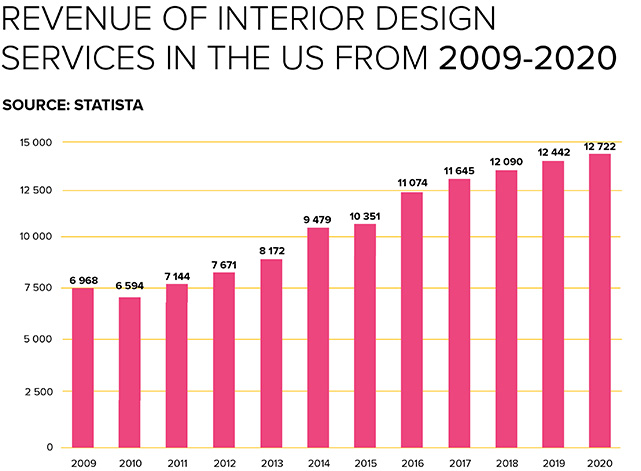
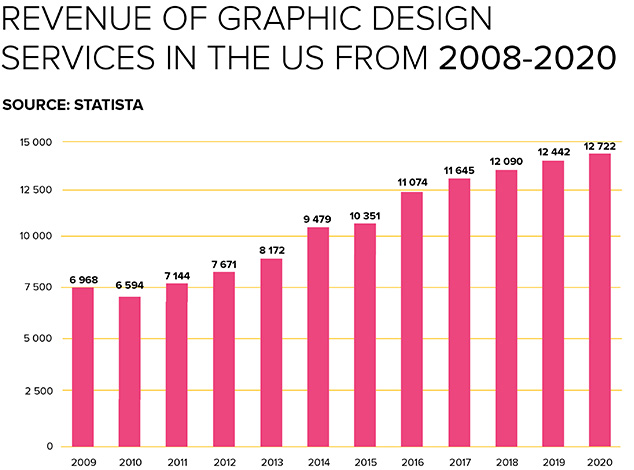
- In 2012, revenue reached more than $60 billion.
- in 2016, the US furniture market reached approximately 10.74 billion.
- Multifunctional furniture design, along with increasingly utilized online retail, have reduced operating costs and will impact industry development through to 2025.
- The graphs below display US furniture industry revenue in 2012, US office furniture market size respectively.
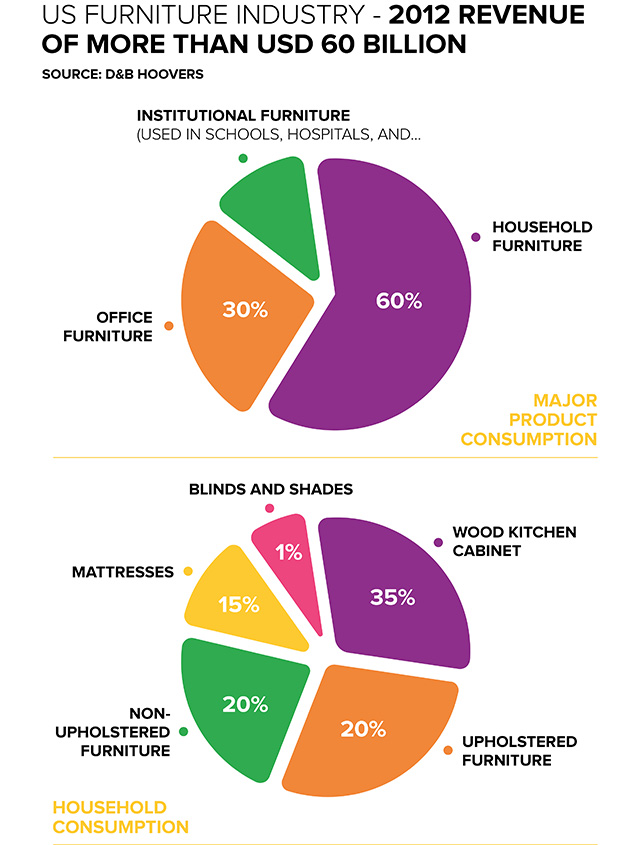
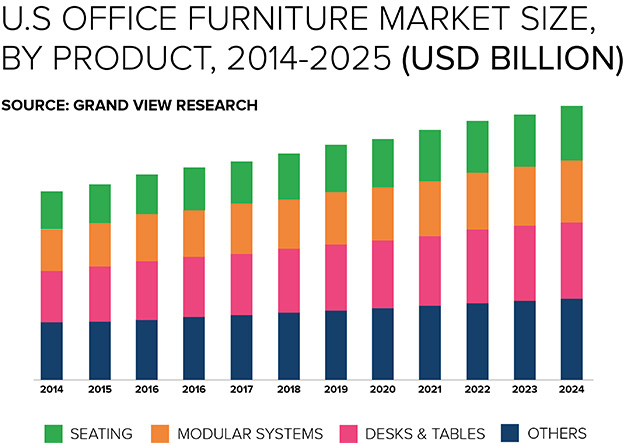

- Downstream advertising agencies comprise a large proportion of industry demand. Professional design studios and freelancers benefit from advertising firms, outsourcing visual design.
- This trend has been declining over the last five years, minimizing industry revenue growth. A growing number of home renovations have increased demand for interior design over this period.

- Graphic designers have played a significant role in helping businesses develop brand identity across print, digital channels, and film over the last five years to 2017. Overall demand for graphic design services from print businesses (i.e., magazines and newspapers) has been low, but digital services have increased overall industry revenue for this same period.
- The industry is expected to show growth in the next few years as demand for graphic design services increases.
Biggest Suppliers and Major Industry Players
Some of the biggest suppliers and top players in the industry have used ingenuity and business savvy to etch out a place in the market.
-
01
 Ege Carpets
Ege CarpetsBoasts a revenue of $290.5K and provide modern and contemporary styles of their catalog of designs. The inspiration for the era before the industrial revolution has inspired colored texture, and design choices and linen is used artistically to mimic aged fabrics.
-
02
 Rene Dekker
Rene DekkerLuxury interior design located in London, and offers exclusive designs for both residential and commercial spaces. Classical style in fabric, color, and structure, enable art to be integrated into the designs.
-
03
 Hartsfabric
HartsfabricThis private firm generates $135.3K in revenue and features fabrics that are hand selected for quality and attractiveness, and stand out from competitors because of their unique selections of fabrics like bamboo, modal, ponte, and organic fabrics.
-
04
 Spoon Flower
Spoon FlowerLuxury interior design located in London, and offers exclusive designs for both residential and commercial spaces. Classical style in fabric, color, and structure, enable art to be integrated into the designs.
What Designers Need to be Equipped With
Insider Information for More Appealing Designs
Artificial Intelligence (AI) can be applied for predicting fabric elements, prior to manufacturing, with the use of Neuro Fuzzy, and other approaches by using yarn, fiber, and fabric constructional data, but it’s important to utilize an appropriate linear and nonlinear relationship between input fiber, yarn parameters, and fabric properties that are going to be forecasted.
But AI can be a costly option for fabric manufacturers and can send production costs into higher expenses territories. AI can investigate the comfort element of fabrics too so that sensory comfort is a consideration.
Leveraging Tools and Technology
Textile fibers are the basic raw material for the production of textiles, and because there are so many types, it’s hard to identify unknown fibers through simple visual inspection. Traditionally, fibers have been identified by using destructive tests like chemicals or flame, but advancements have used optical microscopes, Fourier Transform Infrared, and Raman Spectroscopy.
AI has been a disruptor in this market because it can identify and grade textile fibers by color, length, uniformity, and tenacity among other properties. AI has been used in yarn manufacturing to virtually model yarn based on fiber properties to predict tensile properties and yarn unevenness.
Since fabric quality determines manufacturing ease and productivity, this is an important element to classify, and from a consumer perspective, garment appearance, comfort, and durability are important. AI used for a color solution can assist in predicting what the color will look like when different colored fibers are blended. And AI can be applied for shade sorting and color matching in fabrics.
Where and How to Sell Design Ideas
For a textile designer, who develops artwork that’s printed on fabric, a focus on developing color, and preparing artwork for production and manufacturing is crucial. While the majority of textile designers are employed by companies, many end up becoming owners who sell their prints and designers to firms all over the world. However, understanding how to get to that place where you can sell your textile designs and learn more about industry standards for surface pattern designs for textiles, or selling your copyrights for your textiles, is an important way to get your foot on the door to becoming an entrepreneur.
- Develop a pricing model that you’re confident with.
- Ensure that you can communicate with clients authoritatively and knowledgeable.
- Offer a distinct and unique view of the market and have a direction of where your business can grow.
- Ensure that you can access resources that enable you to license your textile designs.
How to Find Clients

Textile designers should work with their clients to create designs that reflect need, using different concepts and media to develop fabrics such as CAD software programs like Pro-Weave, 3D Mapping, and Photoshop.
To develop new concepts, textile designers have to be able to interpret what their client wants and have the ability to discuss and understand this need and apply it to design research. It’s also important for designers to have the skills to produce effective design samples and present their clients with the visual interpretation of their design whether it’s printed or digital, written or drawn. So, some skills to possess would be sewing, graphic design, and line drawing. Also establishing the right connections within the industry helps to promote long-term success.
How to Improve the Selling Proposition
Selling your design patterns can be challenging, so designers should know the answers to a few important questions first:
-
01
Are you investing a proper amount of time in your business?
-
02
What is your budget?
-
03
How much interaction with customers are you comfortable with every day?
-
04
What’s your experience level in the industry?
Print studios often work with freelance designers and charge a 40%-60% commission on each pattern sale. They can offer valuable feedback to freelance designers also. But for designers who want to create a portfolio of work, and still need some guidance with marketing and sales, contracting an agent is a solid option. Agents can sell patterns for about 35%-60% commission and have the reach to sell pattern designs at major shows or through websites or manufacturing headquarters. This is a particularly effective option for designers who want to keep the copyright to their work.
However, if you are a designer who feels more comfortable having control over the whole sales procedure, your work can be sold directly to manufacturers by going to the manufacturer headquarters or contacting them directly through a password protected a page on their website, or at a booth at a print show. Patterns generally sell for $500-$1000 per design, and booth prices range from $1500-$10,000 depending on a location, show, and size of the booth.
Value Add that Professionals Can Bring to Design
The expertise level of professional graphic designers has a higher associated cost, and they’re able to develop materials and provide solutions that bring a lot of added value.
Other added value includes:
-
01
Knowledge of design standards, marketing tactics, information interpretation.
-
02
Software applications and techniques for compiling information.
-
03
Understanding of well-designed marketing materials.
This value-added proposition can create an 80% increase in business success and can improve the in-production performance of textile products. For example, compact yarns are created by compaction that improves yarn strength and durability and minimizes the hairiness, which provides a lot of value in downstream processing.
Design Challenges
-
01Limited Regulation
Because there are no government guidelines for graphic design, it’s hard for clients to pinpoint distinctions between skill levels in graphic design professionals.
-
02Competition
Graphic design careers are going to grow by 13% between 2010 and 2020 and are going to remain a popular position, so this will make it more difficult for companies to stand out in the market.
-
03Software
Graphic design companies may have difficulties in obtaining client work and showcasing their visual services because a lot of business are using packaged design software in the belief that it’s the same as hiring a skilled graphic designer.
-
04Budget Constraints
Usually when a business has to make some budget cuts, graphic design and marketing are typically the first to be removed in preference of IT or sales.
How to Scale or Cut on Inventory
Before scaling up your graphic design business, you should consider a few points:
-
01
Service inventories are like physical inventories that agencies can pad their resources from the fluctuations of demand and gain benefits from scale economies while improving response time for customers.
-
02
Using the right service inventory forms allows businesses to provide higher quality products, quick response times, and better pricing. Businesses can increase their competitive edge by focusing on service features like speed, personalization, cost, and quality.
Design Patents
Design patents offer protection for how products appear and allow inventors to protect their designs. Patent protections have to be ornamental in nature rather than functional; given the rapidly evolving nature of fashion, design patents aren’t always the best way to protect your work.
-
01The design on Fabric
Designers can protect this with copyright that meets originality standards. US trademark law allows both fabric designs and clothing or footwear designs to be protected, and a design patent protects any “new, original, and ornamental designs” that wouldn’t be obvious to an ordinary designer.
-
02Functionality Limits
There are limits to functionality levels that can reside in “article of manufacture” designs before it is protected by a patent. There is a bar on patent design protections if the design has been available publicly for more than a year. Trademark protection for a fabric or clothing design only exists after the design has received recognition.
-
03Length of Protection
Consider these factors into the decision on the type of protection available for the intellectual property. Trademark protection is based on use and can exist forever if the fabric design remains in circulation.
Create and Produce Your Fabric Texture Design
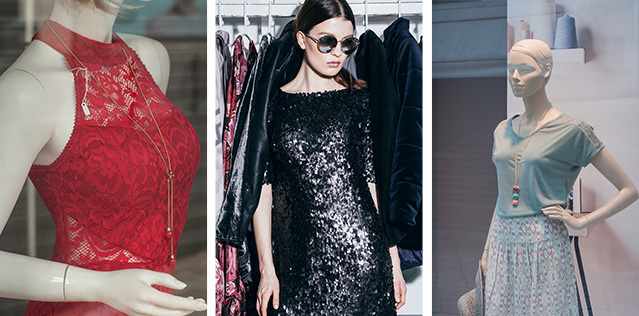
Clothing is no longer simply a functional garment. It’s now a way to express yourself, to showcase design and function, and emphasize creativity and innovation. Manipulation and materials change the elements of design texture and target the most current components of fashion and textile design and furniture fabric texture design. 3D printing, lasers, and electroplating create a tactile surface for fabrics that look sculptural and three dimensional and are helping to shape the nature of fashion design and texture in interior design going forward.
Future textures created by new technologies and genre-blurring materials are changing the nature of the textile industry. The coming decade is going to bring about even more usage of unconventional materials because of the accessibility of supportive technologies that help designers take advantage of new techniques and opportunities for bringing creative design concepts to life.
As design houses and consumers alike look for more originality in design, this will continue to alter and shift the traditional nature of the industry and push it towards a conceptual display of fashion and textile.
Artwork Adobe (AWA) helps designers bring their texture designs to fruition, offering them the ability showcase their products in a way that helps them remain competitive and relevant, and successfully leverage their designs in a crowded and continuously growing market.
AWA works with designers from concept to final production to help generate fabric texture designs that bring together industry trends, art, technology, and fashion in an affordable, efficient collision of design and function.
– Artwork Abode
Disclaimer:All the product names, logos, trademarks, and brand names are the property of their respective owners. All the products, services, and organization names mentioned in this page are for identification purpose only and do not imply endorsement.
Artwork Abode

